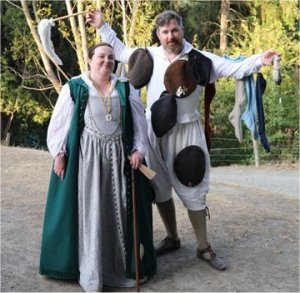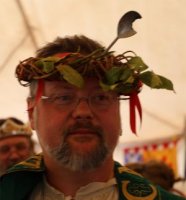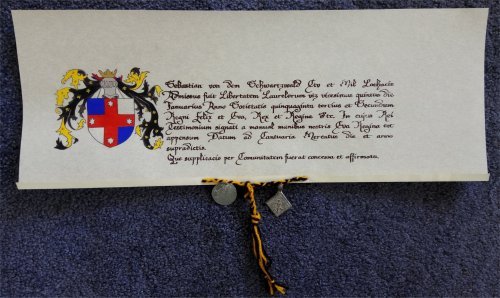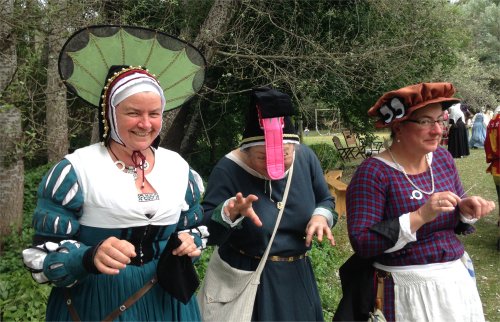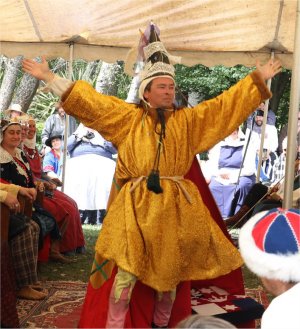 |
|
Peerage Elevations and EntertainmentsGinevra di Serafino Visconti: Of Capering, Clowns and Knitting My Peerage Stuff
I seem to have become involved in customising peerage elevations or providing elevation-related entertainment. It's an interesting challenge balancing the serious and the amusing, but I think I've managed it for the most part. Ginevra di Serafino Visconti: Of Capering, Clowns and Knitting, CFLIVWhen Ginevra was asked to the Order of the Laurel, in recogniton of her skills in knitting, I helped out with her ceremonial script; as with Mistress Anna de Wilde's Pelicanning some years earlier, Ginevra was keen to use some elements from my own elevation ceremony. So we discussed virtues, speakers, the oath of fealty and such things and came up with a suitable draft. One thing which warmed the cockles of my heart was Her Excellency's wish to be robed in my peerage loose gown. As a Pelican becoming a Laurel, and as someone who had helped make my gown, this was utterly and entirely appropriate, as well as a joy to me. The thing Ginevra didn't know about was the slight twist I'd planned for her ceremony. She had asked Master Llewellyn to start the proceedings by begging the boon of the Crown. Some secret exhortations to the Order and some others, and we were ready for a special appearance of the Clown of Lochac (a title Llewellyn was awarded at May Crown for a very slight..ahem..error in addressing the Crown).
Thus we all duly assembled in the courtyard, and around the corner capered Master Llewellyn with a selection of Ginevra's knitting and knitting she had inspired attached all over him (surprisingly, hose make quite convincing flight feathers). He had a strip of angora fur onna stick as a jester's bauble and bells too I think. After some fun with the crowd and His Majesty, Llewellyn then announced that the motley was not that of a fool but a sincere demonstration of the lady's worthiness and industry. And in another lovely touch, Master Gregory had the Canterbury Faire ensemble play the music Ginevra in homage. And it's not just me playing with elevations. That year Sir Vitale made an appearance at Half-Circle Theatre as Vulcan (the smith), being begged for assistance by Vercingetorix and his highly hairy Gothic minions -- oh those wigs! -- to aid them against the invasion of Julius Caesar. Partway through the story Vitale put down his hammer and became a mere mortal, whereupon Tour d'Or Herald Elizabetta Foscari stepped out of the wings to begin with "the strength of the Kingdom comes from..." at which point the audience went dead silent then roared when they figured out what was going on. Another lovely Laurelling! Sebastian von dem Schwartzwald: The Mystery of the Pewterers, CFLIIII was pleased to be able to advise on the laurelling of Sir Sebastian. Sebastian is a maker to the bone, but was being recognised primarily for his pewterwork -- he has supplied the majority of the Canterbury Faire tokens over the past 20 years and many of us have buttons and buckles and pins holding our clothes together thanks to him. So I started looking at the Pewterers' Guild and their ceremonies and oaths. A book on their history proved used for ordinances and charters, the Mysteries having been founded in 1473. I was lucky enough to find, in the bowels of a dusty secondhand bookshop, the immensely useful booklet by Vivienne Aldous, My Ancestors were Freemen of the City of London (Society of Geneaologists, 1999) about the history of admission to the Freedom of the City of London. Elements from all these ended up informing Sebastian's ceremony. The pared-back ceremony began with Sebastian, in his work-apron, following me up the aisle at Court with a tray covered in all mannner of jewellery, badges, buttons, coronets, tokens, coins, lanterns and the like. I asked the Baron and Baroness of Southron Gaard for their coronets (promising, of course, to return them), and added them to the pile to speak of the"weighty matter" they represented: This is but a small selection of the skill and talent in the arts metallurgical demonstrated over these many years by Your subject Sebastian von dem Schwartzwald. I have watched this man grow into his learning, inspire others, teach many on all manner of subjects. He is someone whose approval I seek out for I know he will ask the awkward questions that make me a better artisan, and even more so, make me want to be a better Laurel. He is truly my peer — nay, my better -- within the realm of the arts and sciences. I beg you, at my earnest and especial suit, to recognise him as such. The suit models the types of petitions made on behalf of candidates seeking admission to Livery Companies or the Freedom of the City of London. The suit was answered after the fealty oath with the Herald starting the patent of arms litany with: Que supplicacio per Comunitatem fuerat concessa et affirmata. That is a Latin phrase commonly used to respond to such a plea and translates as "petition granted and allowed" (Hist Pewt; pg 14). Sir Francis Drake and Sir Walter Ralegh managed to get their petitions in support of such supplicants granted, and their suits are recorded in the History of the Pewterers (pg 296): 1586-7. (at this court [20th January] Isaake Tucker at the earnyst sute of Sr water Rawghley was receved into the felloshipe and company of vs the pewterers and was sworne and mad fre and also at the yeld haule the same daye vppon the consideration therof he payed vnto the house x ti. of good and lawfull money of Ingland this is to be noted that the court dyd myttygat his fyne at the sute of S r water Rawghly his master or els he had payed accordyng to the fyrst determynation of a court held the x th of december last xx ti. The other period entryways were not appropriate to model:
That said, the 1583 reference to promising to pay for the construction of a fountain was most tempting....(Hist Pewt pg 292). I really wanted to note the important Mysterie requirements that he promise to appear in Order pageants and be prepared to support them as a whiffler (basically a roadie), but that was going a bit too far....(Hist Pewt, pg 3, 9)
The Mysterie apparently would provide garlands or chaplets for new Masters and their wives. Their history mentions these and included a drawing of what looked like a large willow garland with a pewter casting of the Company’s symbol attached, along with red satin tassels. (Hist Pewt, pg 2, 30, 34). The drawing represents garlands given to the in-coming Master Robert Chamberlain and his wife Cecily in 1463 (I have my doubts). According to the Company’s Jury Book of accounts from that period: When I walked through a local park and noticed some nice long willow withies, I decided that it was a sign that a garland should be made. So I made one and garnished it with a pewter spoon – I had hung onto this spoon for many years after my children had passed it through a candle which blew a large chunk out of the bowl. I knew it would come in useful one day….Master Sebastian was kind enough to wear it...briefly.
The Freedom of the City book included reproductions of certificates for new members admitted into the City of London, and further research provided more examples which formed the basis for an informal writ as a form of Letter Patent. The Latin came from the Freedom certificates (Aldous, pg 2), with my own adaptation for SCA use:
Or: As this was not an official scroll or Patent, just a gift from me to mark the occasion, I consulted with Her Majesty regarding what arms to use on it – it ended up with the Lochac populace arms, Sir Sebastian’s mantling (counterchanged sable and or with estoiles), and two “seals” consisting of one of the earliest Canterbury Faire tokens struck by Sebastian (AS31) and the pewter token he had cast for the previous year’s Faire (AS53), thus spanning his artisanal offerings. Her Majesty was kind enough to sign it at the top above the text, as was not uncommon in period formats. And there was much rejoicing! Alliette Delecourt: The Laurel episode of the Secret Life of Peers, CFLIIIA chance remark by Countess Tailltiu ghoirt ruaidh spoofing a David Attenborough-esque inquiry into the nature of Laurels set in chain another special elevation entertainment. Alliette had chosen to be elevated at Canterbury Faire so a bunch of people worked on honouring the good lady and her penchant for late-period hattage, with a special item for Half-Circle Theatre (repeated at Court next day for better lighting). Tailltiu wrote a lovely piece covering the various life stages of the Laurel: the larval, the nymph, the maturing hatted Laurel, the mature French-hooded and the stealth Laurel. That was presented by Daffyd Attenbury (Master Llewellyn) as part of a purported series The Secret Life of Peers; the cream Tudor outfit Llewellyn generally wears was perfect for the part, as was his quiet, slightly hesitant delivery that channelled Attenborough to a T. But the real stars of the show were the headware, most of them crafted by the amazing Lady Ceina of Ballyhawke. The Larval Stage To a rustle of leaves, Alliette appeared in her simple coif. She had no idea what the play was about or that it was honouring her -- I just told her to take some needlework on stage and run off startled when Llewellyn moved. She seemed gratifyingly stunned when I confessed just as I pushed her on-stage. The Nymph Stage
The Laurel appeared on stage in a flat cap and coif, to the words: As Daffyd flapped his hands, the Laurel nymph (Mistress Miriam Galbraith) hissed and unhooked the flat cap to reveal a pair of googly eyes. The Maturing Hatted Laurel The Hatted Laurel (Mistress Montjoye) bounced on stage a la Monarch of the Glen; when poked with Daffyd's stick she set off her hat, revealing a lolling tongue and big nasty teeth.
The Mature French-hooded Laurel This Laurel (Mistress Rowan) promenaded on stage, then bristled at the age comment, screeching "Did you just call me decrepit?!". At the same time she pulled the pin on her hat which immediately flared up around her head like an angry frilled lizard. It was great!
The Stealth Laurel Cue Master Brian's entrance. I had tried making this final hat, a monstrous princess hennin creation of gold glitter and lame and chiffon, to match Master Brian's...ahem...shy and retiring nature. He thought it wasn't garish enough so added more of his Very Special Magic to it. At the Half-Circle Theatre performance, in near darkness, this was most fortuitous, as one of his additions was a cluster of fairy lights, which let the audience see him pop out from behind the Royal Box and make his way down to the stage. We managed to close down the performance with a couple of constables appearing: And there was much rejoicing. Tailltiu keeps threatening to produce a Pelican episode...
| ||||||||||||||||||||||||||||||||||||||||||||||||||||||
